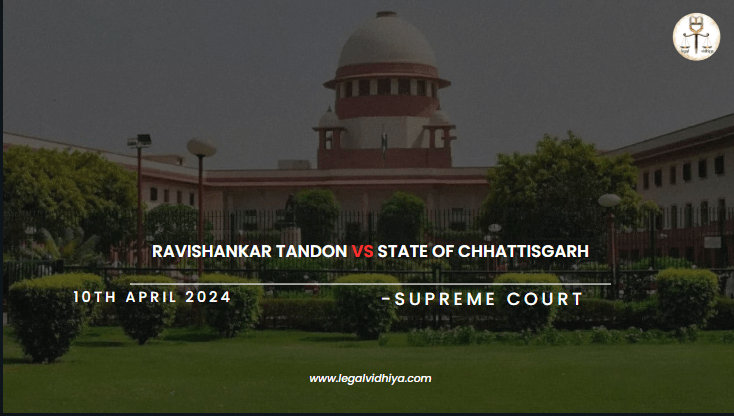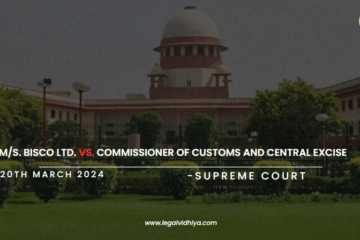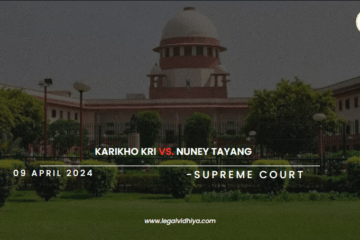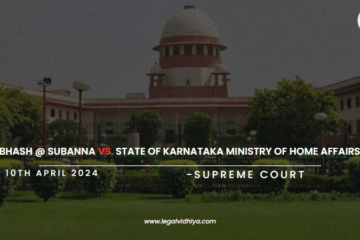
| CITATION | 2024 SCC 299 |
| DATE OF JUDGEMENT | 10th April 2024 |
| COURT | Supreme Court of India |
| APPELLANTS | RAVISHANKAR TANDON AND 3 OTHERS |
| RESPONDENT | STATE OF CHHATTISGARH |
| BENCH | JUSTICE BR GAVAI, JUSTICE SANDEEP MEHTA. |
INTRODUCTION
In the case of State of Chhattisgarh v. Ravishankar Tandon, the appellants were found guilty of Dharmendra Satnami’s murder. On January 2, 2023, the High Court of Chhattisgarh upheld the judgement and sentence. Following a report of Dharmendra missing from his father Ramavtar (PW-1), an investigation was launched. During the course of the investigation, the appellants reportedly confessed to the murder, claiming to have strangled Dharmendra and dumped his body in a pond. The police filed a FIR and started legal processes in response to this confession and the body’s finding. The prosecution was unable to establish guilt beyond a reasonable doubt, according to the defence, and there was insufficient circumstantial evidence. The prosecution said that, in light of the facts, the trial court and the High Court appropriately determined the appellants’ guilt. Now, the claims must be assessed by the Supreme Court in light of the stringent guidelines for circumstantial evidence established in Sharad Birdhichand Sarda v. State of Maharashtra. These guidelines stipulate that the evidence must be definitive and rule out any alternative plausible explanation for the defendant’s innocence. In order to confirm that the information led to the discovery of facts known to the accused, the admissibility of the appellants’ statements under Section 27 of the Indian Evidence Act, 1872, will also be carefully examined. The application of circumstantial evidence in criminal cases will be impacted by this ruling in the future.
FACTS OF THE CASE
- During questioning, it was discovered that the accused had planned to kill the deceased in exchange for Rs. 90,000.
- According to the appellant’s statements, the police retrieved the deceased person from the Bhatgaon pond.
- Throughout the trial, a number of witnesses gave testimony, and the prosecution produced 37 documents to support the accused’s guilt. The accused chose a trial and entered a not guilty plea.
- Following the death, a missing person’s file was filed, and the post-mortem examination verified that the victim had asphyxiated from strangulation.
- The current appeals contest the ruling and directive issued by the Division Bench of the Chhattisgarh High Court in Bilaspur on January 2, 2023.
- The appellants were found guilty after the trial court determined that the prosecution had established the case against them beyond a reasonable doubt.
- While Accused No. 4 was found guilty under Sections 302 and 120B of the IPC, Accused Nos. 1, 2, and 3 were found guilty for crimes under Sections 302, 120B, and 201 of the IPC. Each of the defendants received a life sentence in jail and penalties.
- The conviction and sentence imposed by the trial court in Sessions Trial No. 10 of 2012 were upheld by the Division Bench of the High Court, which also dismissed the appellants’ criminal appeals.
ISSUES RAISED
- Were the statements made under Section 27 of the Evidence Act allowed as evidence, especially in proving their connection to finding the dead body?
- Can we trust the testimonies of witnesses like Ramkumar (PW-5) and Ajab Singh (PW-18), given the differences in their accounts about when and how they learned of the murder and the discovery of the body?
- Is there a disagreement about whether certain evidence, like statements under Section 27 of the Evidence Act, is legally valid? This raises concerns about how accurate the prosecution’s evidence is and if the case was handled correctly.
CONTENTIONS OF THE APPELLANTS
- Circumstantial evidence is the primary kind of support in this case. Against every reasonable doubt, the appellants contend that the prosecution failed to prove any incriminating circumstances. They further claim that a complete collection of evidence proving the accused’s guilt could not be produced by the prosecution.
- The appellants disagree with the High Court’s decision, which upheld the conviction and sentence imposed by the trial court. They argue that both judges made mistakes by inferring guilt based only on circumstantial evidence.
- In order to bring forth legal ideas of conviction based on circumstantial evidence, the appellants cite Sharad Birdhichand Sarda v. State of Maharashtra. The importance of the facts being fully proved, conclusive, consistent only with the accused’s guilt, and ruling out any other possible explanation for the circumstances—except guilt—is emphasised.
- The appellants have raised issues over the application of Section 27 of the Indian Evidence Act. They have emphasised that the prosecution must demonstrate that the information the accused provided during their incarceration led to the discovery of a fact that was evidently within their knowledge. According to them, only this type of information can be used as evidence.
- In their closing remarks, the appellants assert that there is an assumption of innocence up until and unless a person is proven guilty beyond a reasonable doubt. This underlines the idea that suspicion—no matter how strong—cannot be used in lieu of evidence. They contend that the burden of establishing guilt beyond a reasonable doubt is with the prosecution.
CONTENTIONS OF RESPONDENT
- In both the trial court and the High Court, the respondent contends that the prosecution has demonstrated the case beyond a reasonable doubt. They argue that the rulings rendered by both courts were backed by strong evidence, hence there should be no need for intervention.
- Even if the case is based on circumstantial evidence, the respondent maintains that the conviction is justified. According to established judicial precedents, they argue, the prosecution proved the accused’s guilt beyond a reasonable doubt.
- The respondent contests the appellants’ claims that the prosecution failed to present a complete chain of proven facts or adequate proof of an incriminating situation. They argue that the trial’s evidence sufficiently supports the accused’s conviction.
- The respondent seems to have placed a great deal of weight on past decisions that support convictions based on circumstantial evidence, indicating that the courts in this specific case correctly applied established guidelines.
- Finally, the respondent underscores how important it is to abide by the decisions made by the trial court and the High Court and stresses the need for substantial evidence to overturn their findings. They argue that the appeals should be dismissed because there aren’t any valid reasons in this case.
JUDGEMENT
In the case of Ravishankar Tandon vs. State of Chhattisgarh, the appellants challenged their conviction and sentence for the murder of Dharmendra Satnami. The prosecution’s case relied on circumstantial evidence, including the memorandum statements of the accused and the subsequent recovery of the victim’s body from a pond. The court emphasized the importance of circumstantial evidence, stating that for a conviction to be upheld, the circumstances must be fully established and must lead to no other conclusion than the guilt of the accused.
Furthermore, the court discussed the application of Section 27 of the Indian Evidence Act, which allows for the admission of incriminating statements made by the accused if they lead to the discovery of a fact within their knowledge. It highlighted that only the information directly related to the discovered fact can be admissible as evidence.
Upon analyzing the evidence presented, the court found that the prosecution had convincingly demonstrated that the recovery of the victim’s body was a direct result of the information provided by the accused while in police custody. Therefore, the court concluded that the appellants’ guilt had been proven beyond a reasonable doubt.
As a result, the court upheld the conviction and sentence imposed by the trial court, dismissing the appeals filed by the appellants. This case serves as a significant example of the legal principles surrounding circumstantial evidence and the admissibility of statements made by the accused during police custody.
ANALYSIS
- According to Section 27 of the Indian Evidence Act, when something is discovered, it must be disclosed along with its location and the accused’s knowledge of it.
- In order to condemn someone on the basis of circumstantial evidence, you must have all the pieces of evidence that unequivocally show that the defendant is guilty.
- The information that is disclosed must be freely provided and pertinent to the item that was discovered.
- The proof must be unambiguous in establishing a person’s guilt and must exclude any possibility of innocence.
- Strict guidelines were established in the Hanumant v. State of Madhya Pradesh case for cases involving circumstantial evidence.
- Upon discovering something, you should ascertain its nature, its origin, and whether the individual in question was aware of it.
- Something “may be proved” is not the same as something that “must be or should be proved.”
- Merely possessing a strong sense that someone is guilty does not establish their guilt. To be sure, you need reliable proof.
- Witnesses and the accused have stated that they were informed about Dharmendra’s death by both the police and before the accused made their testimonies under Section 27 of the Evidence Act.
- The information provided by the accused appears dubious because of the discrepancies in the dates that the police informed the witnesses about the murder and the times that the accused made their statements.
- The accused’s disclosure statements were not sufficient to establish that the discovery of the dead body was the only basis for the prosecution’s case.
- Ajab Singh, the witness, said that he signed documents without reading them, raising the possibility that they were altered.
- The evidence does not conclusively show that the accused’s remarks made in accordance with Section 27 caused the corpse to be discovered.
- The investigating officer made no mention of the precise information that the accused supplied to assist in locating the deceased corpse. It is underlined that information acquired under Section 27 must be precise and not just broad in nature, and it must relate to the particular fact disclosed.
- The prosecution was unable to provide adequate evidence that the accused’s statements were the only factor in the dead body’s retrieval.
- The intent of Section 27, which wasn’t made evident in this instance, is to ensure that the information provided is trustworthy by explicitly linking it to a discovered truth.
- The prosecution was unable to establish any instances in which the appellants were guilty.
- The totality of the evidence must support the accused’s guilt, which is not the case in this instance.
CONCLUSION
The conclusion of the case was that the court upheld the conviction and punishment of the accused individuals for the murder of Dharmendra Satnami. The court found that the prosecution had successfully proven the guilt of the accused beyond a reasonable doubt based on circumstantial evidence and the statements made by the accused themselves. As a result, the appeals filed by the accused challenging their conviction were rejected, and the decision of the trial court was upheld.
REFERENCES
- SCC Online
- https://newslaw.in/case-type/criminal/understanding-legal-judgments-ravishankar-tandon-vs-state-of-chhattisgarh-conviction-reversed/#:~:text=Ravishankar%20Tandon%20(Accused%20Persons)%20involves,guilt%20beyond%20a%20reasonable%20doubt
- https://www.advocatekhoj.com/library/judgments/announcement.php
This article is written by Vedika Tiwari, student of Allahabad University, Prayagraj, intern at Legal Vidhiya.
Disclaimer: The materials provided herein are intended solely for informational purposes. Accessing or using the site or the materials does not establish an attorney-client relationship. The information presented on this site is not to be construed as legal or professional advice, and it should not be relied upon for such purposes or used as a substitute for advice from a licensed attorney in your state. Additionally, the viewpoint presented by the author is of a personal nature.




0 Comments